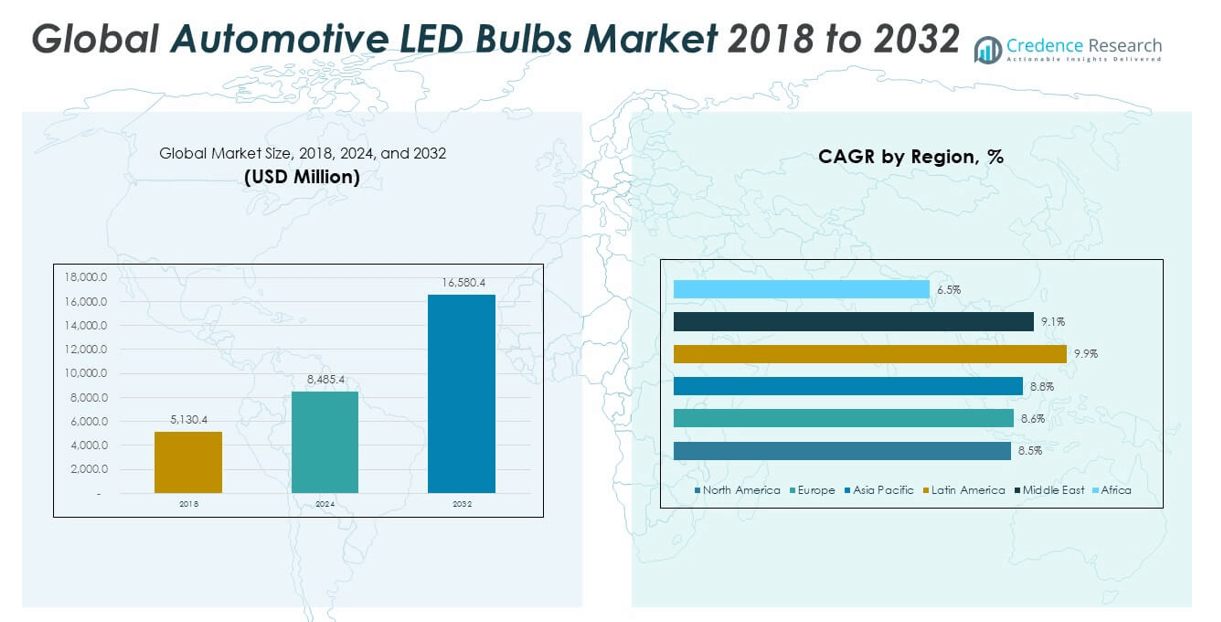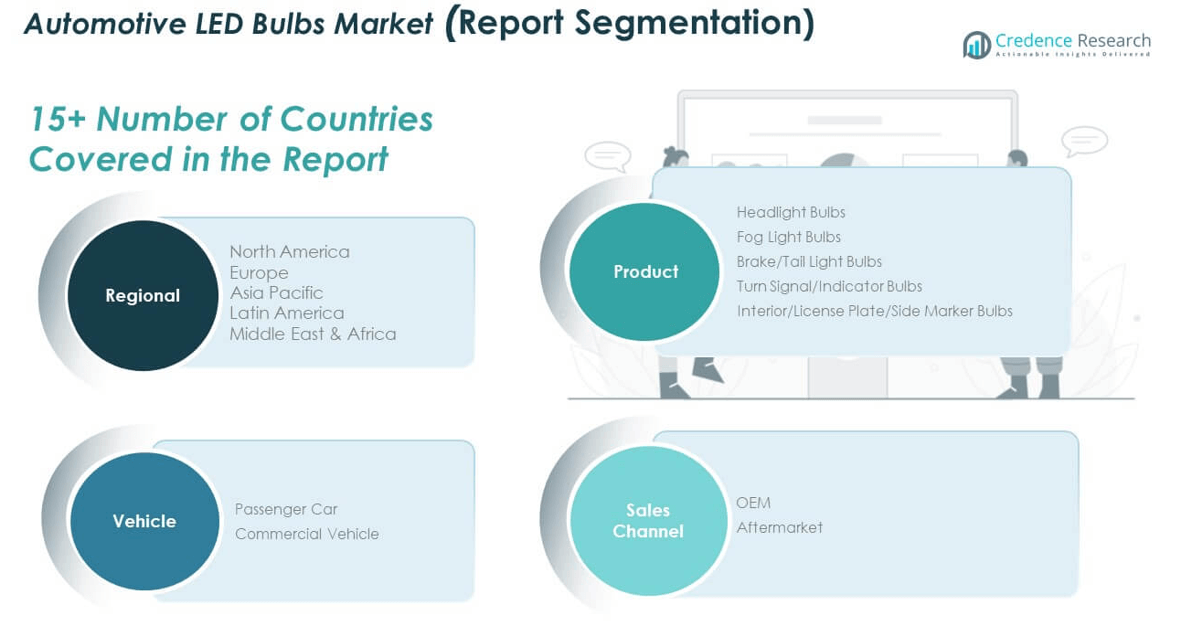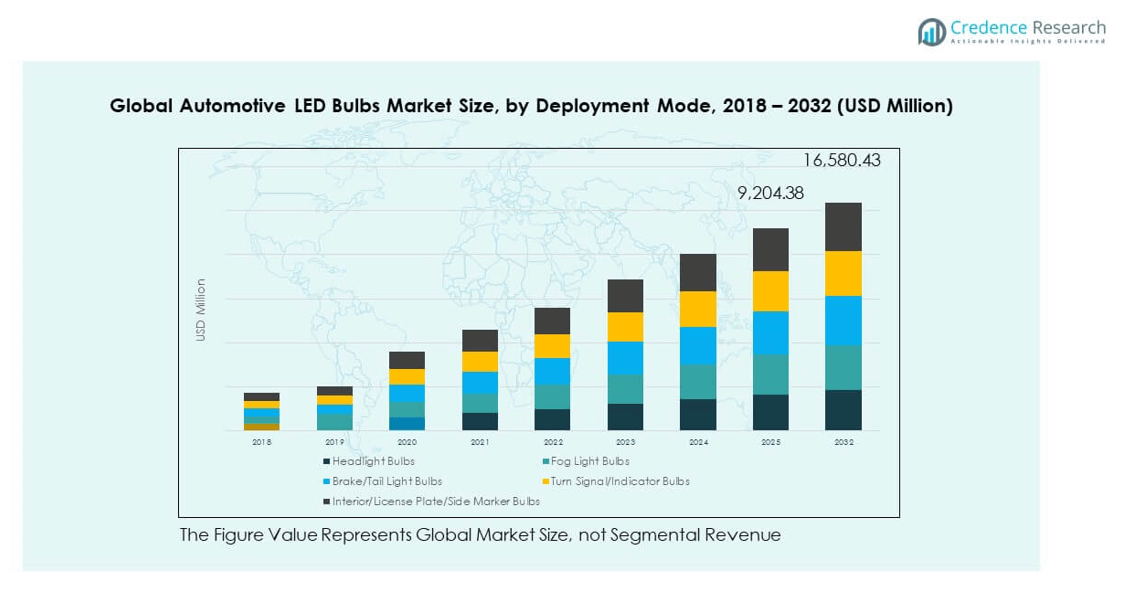CHAPTER NO. 1 : GENESIS OF THE MARKET
1.1 Market Prelude – Introduction & Scope
1.2 The Big Picture – Objectives & Vision
1.3 Strategic Edge – Unique Value Proposition
1.4 Stakeholder Compass – Key Beneficiaries
CHAPTER NO. 2 : EXECUTIVE LENS
2.1 Pulse of the Industry – Market Snapshot
2.2 Growth Arc – Revenue Projections (USD Million)
2.3. Premium Insights – Based on Primary Interviews
CHAPTER NO. 3 : AUTOMOTIVE LED BULBS MARKET FORCES & INDUSTRY PULSE
3.1 Foundations of Change – Market Overview
3.2 Catalysts of Expansion – Key Market Drivers
3.2.1 Momentum Boosters – Growth Triggers
3.2.2 Innovation Fuel – Disruptive Technologies
3.3 Headwinds & Crosswinds – Market Restraints
3.3.1 Regulatory Tides – Compliance Challenges
3.3.2 Economic Frictions – Inflationary Pressures
3.4 Untapped Horizons – Growth Potential & Opportunities
3.5 Strategic Navigation – Industry Frameworks
3.5.1 Market Equilibrium – Porter’s Five Forces
3.5.2 Ecosystem Dynamics – Value Chain Analysis
3.5.3 Macro Forces – PESTEL Breakdown
3.6 Price Trend Analysis
3.6.1 Regional Price Trend
3.6.2 Price Trend by Product
CHAPTER NO. 4 : KEY INVESTMENT EPICENTER
4.1 Regional Goldmines – High-Growth Geographies
4.2 Product Frontiers – Lucrative Product Categories
4.3 Vehicle Sweet Spots – Emerging Demand Segments
CHAPTER NO. 5: REVENUE TRAJECTORY & WEALTH MAPPING
5.1 Momentum Metrics – Forecast & Growth Curves
5.2 Regional Revenue Footprint – Market Share Insights
5.3 Segmental Wealth Flow – Product, Vehicle, & Sales Channel Revenue
CHAPTER NO. 6 : TRADE & COMMERCE ANALYSIS
6.1. Import Analysis by Region
6.1.1. Global Automotive LED Bulbs Market Import Volume By Region
6.2. Export Analysis by Region
6.2.1. Global Automotive LED Bulbs Market Export Volume By Region
CHAPTER NO. 7 : COMPETITION ANALYSIS
7.1. Company Market Share Analysis
7.1.1. Global Automotive LED Bulbs Market: Company Market Share
7.1. Global Automotive LED Bulbs Market Company Volume Market Share
7.2. Global Automotive LED Bulbs Market Company Revenue Market Share
7.3. Strategic Developments
7.3.1. Acquisitions & Mergers
7.3.2. New Product Launch
7.3.3. Regional Expansion
7.4. Competitive Dashboard
7.5. Company Assessment Metrics, 2024
CHAPTER NO. 8 : AUTOMOTIVE LED BULBS MARKET – BY PRODUCT SEGMENT ANALYSIS
8.1. Automotive LED Bulbs Market Overview By Product Segment
8.1.1. Automotive LED Bulbs Market Volume Share By Product
8.1.2. Automotive LED Bulbs Market Revenue Share By Product
8.2. Headlight Bulbs
8.3. Fog Light Bulbs
8.4. Brake/Tail Light Bulbs
8.5. Turn Signal/Indicator Bulbs
8.6. Interior/License Plate/Side Marker Bulbs
CHAPTER NO. 9 : AUTOMOTIVE LED BULBS MARKET – BY VEHICLE SEGMENT ANALYSIS
9.1. Automotive LED Bulbs Market Overview By Vehicle Segment
9.1.1. Automotive LED Bulbs Market Volume Share By Vehicle
9.1.2. Automotive LED Bulbs Market Revenue Share By Vehicle
9.2. Passenger Car
9.3. Commercial Vehicle
CHAPTER NO. 10 : AUTOMOTIVE LED BULBS MARKET – BY SALES CHANNEL SEGMENT ANALYSIS
10.1. Automotive LED Bulbs Market Overview By Sales Channel Segment
10.1.1. Automotive LED Bulbs Market Volume Share By Sales Channel
10.1.2. Automotive LED Bulbs Market Revenue Share By Sales Channel
10.2. OEM
10.3. Aftermarket
CHAPTER NO. 11 : AUTOMOTIVE LED BULBS MARKET – REGIONAL ANALYSIS
11.1. Automotive LED Bulbs Market Overview By Region Segment
11.1.1. Global Automotive LED Bulbs Market Volume Share By Region
11.1.2. Global Automotive LED Bulbs Market Revenue Share By Region
11.1.3. Regions
11.1.4.Global Automotive LED Bulbs Market Volume By Region
11.1.5. Global Automotive LED Bulbs Market Revenue By Region
11.1.6. Product
11.1.7. Global Automotive LED Bulbs Market Volume By Product
11.1.8. Global Automotive LED Bulbs Market Revenue By Product
11.1.9. Vehicle
11.1.10. Global Automotive LED Bulbs Market Volume By Vehicle
11.1.11. Global Automotive LED Bulbs Market Revenue By Vehicle
11.1.12. Sales Channel
11.1.13. Global Automotive LED Bulbs Market Volume By Sales Channel
11.1.14. Global Automotive LED Bulbs Market Revenue By Sales Channel
CHAPTER NO. 12 : NORTH AMERICA AUTOMOTIVE LED BULBS MARKET – COUNTRY ANALYSIS
12.1. North America Automotive LED Bulbs Market Overview By Country Segment
12.1.1. North America Automotive LED Bulbs Market Volume Share By Region
12.1.2. North America Automotive LED Bulbs Market Revenue Share By Region
12.2. North America
12.2.1. North America Automotive LED Bulbs Market Volume By Country
12.2.2. North America Automotive LED Bulbs Market Revenue By Country
12.2.3. Product
12.2.4. North America Automotive LED Bulbs Market Volume By Product
12.2.5. North America Automotive LED Bulbs Market Revenue By Product
12.2.6. Vehicle
12.2.7. North America Automotive LED Bulbs Market Volume By Vehicle
12.2.8. North America Automotive LED Bulbs Market Revenue By Vehicle
12.2.9.Sales Channel
12.2.10. North America Automotive LED Bulbs Market Volume By Sales Channel
12.2.11. North America Automotive LED Bulbs Market Revenue By Sales Channel
12.3. U.S.
12.4. Canada
12.5. Mexico
CHAPTER NO. 13 : EUROPE AUTOMOTIVE LED BULBS MARKET – COUNTRY ANALYSIS
13.1. Europe Automotive LED Bulbs Market Overview By Country Segment
13.1.1. Europe Automotive LED Bulbs Market Volume Share By Region
13.1.2. Europe Automotive LED Bulbs Market Revenue Share By Region
13.2. Europe
13.2.1. Europe Automotive LED Bulbs Market Volume By Country
13.2.2. Europe Automotive LED Bulbs Market Revenue By Country
13.2.3. Product
13.2.4. Europe Automotive LED Bulbs Market Volume By Product
13.2.5. Europe Automotive LED Bulbs Market Revenue By Product
13.2.6. Vehicle
13.2.7. Europe Automotive LED Bulbs Market Volume By Vehicle
13.2.8. Europe Automotive LED Bulbs Market Revenue By Vehicle
13.2.9.Sales Channel
13.2.10. Europe Automotive LED Bulbs Market Volume By Sales Channel
13.2.11. Europe Automotive LED Bulbs Market Revenue By Sales Channel
13.3. UK
13.4. France
13.5. Germany
13.6. Italy
13.7. Spain
13.8. Russia
13.9. Rest of Europe
CHAPTER NO. 14 : ASIA PACIFIC AUTOMOTIVE LED BULBS MARKET – COUNTRY ANALYSIS
14.1. Asia Pacific Automotive LED Bulbs Market Overview By Country Segment
14.1.1. Asia Pacific Automotive LED Bulbs Market Volume Share By Region
14.1.2. Asia Pacific Automotive LED Bulbs Market Revenue Share By Region
14.2. Asia Pacific
14.2.1. Asia Pacific Automotive LED Bulbs Market Volume By Country
14.2.2. Asia Pacific Automotive LED Bulbs Market Revenue By Country
14.2.3. Product
14.2.4. Asia Pacific Automotive LED Bulbs Market Volume By Product
14.2.5. Asia Pacific Automotive LED Bulbs Market Revenue By Product
14.2.6. Vehicle
14.2.7. Asia Pacific Automotive LED Bulbs Market Volume By Vehicle
14.2.8. Asia Pacific Automotive LED Bulbs Market Revenue By Vehicle
14.2.9.Sales Channel
14.2.10. Asia Pacific Automotive LED Bulbs Market Volume By Sales Channel
14.2.11. Asia Pacific Automotive LED Bulbs Market Revenue By Sales Channel
14.3. China
14.4. Japan
14.5. South Korea
14.6. India
14.7. Australia
14.8. Southeast Asia
14.9. Rest of Asia Pacific
CHAPTER NO. 15 : LATIN AMERICA AUTOMOTIVE LED BULBS MARKET – COUNTRY ANALYSIS
15.1. Latin America Automotive LED Bulbs Market Overview By Country Segment
15.1.1. Latin America Automotive LED Bulbs Market Volume Share By Region
15.1.2. Latin America Automotive LED Bulbs Market Revenue Share By Region
15.2. Latin America
15.2.1. Latin America Automotive LED Bulbs Market Volume By Country
15.2.2. Latin America Automotive LED Bulbs Market Revenue By Country
15.2.3. Product
15.2.4. Latin America Automotive LED Bulbs Market Volume By Product
15.2.5. Latin America Automotive LED Bulbs Market Revenue By Product
15.2.6. Vehicle
15.2.7. Latin America Automotive LED Bulbs Market Volume By Vehicle
15.2.8. Latin America Automotive LED Bulbs Market Revenue By Vehicle
15.2.9.Sales Channel
15.2.10. Latin America Automotive LED Bulbs Market Volume By Sales Channel
15.2.11. Latin America Automotive LED Bulbs Market Revenue By Sales Channel
15.3. Brazil
15.4. Argentina
15.5. Rest of Latin America
CHAPTER NO. 16 : MIDDLE EAST AUTOMOTIVE LED BULBS MARKET – COUNTRY ANALYSIS
16.1. Middle East Automotive LED Bulbs Market Overview By Country Segment
16.1.1. Middle East Automotive LED Bulbs Market Volume Share By Region
16.1.2. Middle East Automotive LED Bulbs Market Revenue Share By Region
16.2. Middle East
16.2.1. Middle East Automotive LED Bulbs Market Volume By Country
16.2.2. Middle East Automotive LED Bulbs Market Revenue By Country
16.2.3. Product
16.2.4. Middle East Automotive LED Bulbs Market Volume By Product
16.2.5. Middle East Automotive LED Bulbs Market Revenue By Product
16.2.6. Vehicle
16.2.7. Middle East Automotive LED Bulbs Market Volume By Vehicle
16.2.8. Middle East Automotive LED Bulbs Market Revenue By Vehicle
16.2.9. Sales Channel
16.2.10. Middle East Automotive LED Bulbs Market Volume By Sales Channel
16.2.11. Middle East Automotive LED Bulbs Market Revenue By Sales Channel
16.3. GCC Countries
16.4. Israel
16.5. Turkey
16.6. Rest of Middle East
CHAPTER NO. 17 : AFRICA AUTOMOTIVE LED BULBS MARKET – COUNTRY ANALYSIS
17.1. Africa Automotive LED Bulbs Market Overview By Country Segment
17.1.1. Africa Automotive LED Bulbs Market Volume Share By Region
17.1.2. Africa Automotive LED Bulbs Market Revenue Share By Region
17.2. Africa
17.2.1. Africa Automotive LED Bulbs Market Volume By Country
17.2.2. Africa Automotive LED Bulbs Market Revenue By Country
17.2.3. Product
17.2.4. Africa Automotive LED Bulbs Market Volume By Product
17.2.5. Africa Automotive LED Bulbs Market Revenue By Product
17.2.6. Vehicle
17.2.7. Africa Automotive LED Bulbs Market Volume By Vehicle
17.2.8. Africa Automotive LED Bulbs Market Revenue By Vehicle
17.2.9.Sales Channel
17.2.10. Africa Automotive LED Bulbs Market Volume By Sales Channel
17.2.11. Africa Automotive LED Bulbs Market Revenue By Sales Channel
17.3. South Africa
17.4. Egypt
17.5. Rest of Africa
CHAPTER NO. 18 : COMPANY PROFILES
18.1. Magneti Holdings CO., LTD.
18.1.1. Company Overview
18.1.2. Product Portfolio
18.1.3. Financial Overview
18.1.4.Recent Developments
18.1.5. Growth Strategy
18.1.6. SWOT Analysis
18.2. OSRAM GmbH
18.3. Robert Bosch GmbH
18.4. Denso Corporation
18.5. Stanley Electric Co., Ltd.
18.6. Hella GmbH & Co. KGaA
18.7. ZKW Group GmbH
18.8. Nichia Corporation
18.9. Cree, Inc.
18.10. Morimoto Lighting
18.11. Lumileds Holding B.V.
18.12. Other Key Players






